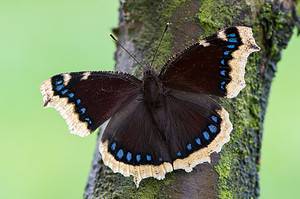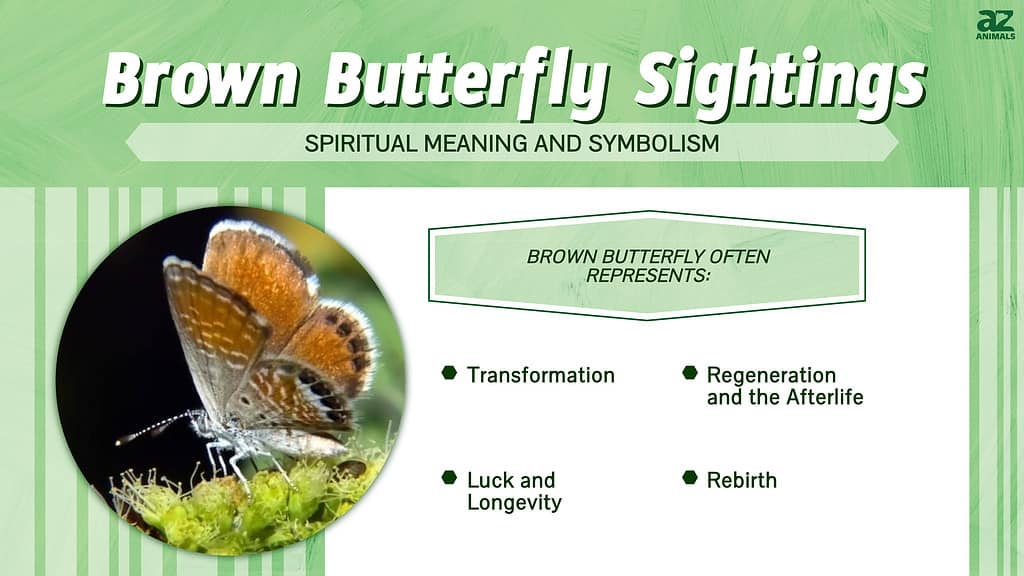
Around the world, the arrival of spring means the reappearance of butterflies emerging from their winter dormancy. Butterflies are an incredibly old and common animal, dating back to the Paleocene era (56 million years ago) and living on every continent except Antarctica. These insects are remarkable for their fluttering flight pattern, colorful wings, and most notably for undergoing metamorphosis. Metamorphosis is the dramatic transformation of butterflies from egg to caterpillar, pupa, and finally adult. This process is a key part of how humans interpret and symbolize butterflies.

The western pygmy-blue (
Brephidium exilis) is a brown butterfly native to Arizona. The blue coloring is only visible when its wings are spread open.
©Deep Desert Photography/Shutterstock.com
So, what does it mean if you see a brown butterfly? As a result of their unique traits, butterflies are a figure in spirituality and art across many cultures. In this article, we will explore the spiritual meaning and symbolism of brown butterflies across time, culture, and history. Butterflies appear as a symbol in ancient Egyptian, Chinese, and Renaissance European cultures. These insects continue to intrigue and inspire people to this day, and there is a rich history to draw from when interpreting a brown butterfly sighting. To conclude, this article explores how the color brown adds another layer of meaning to butterfly sightings through the lens of color psychology.
Brown Butterfly Meanings Across Culture
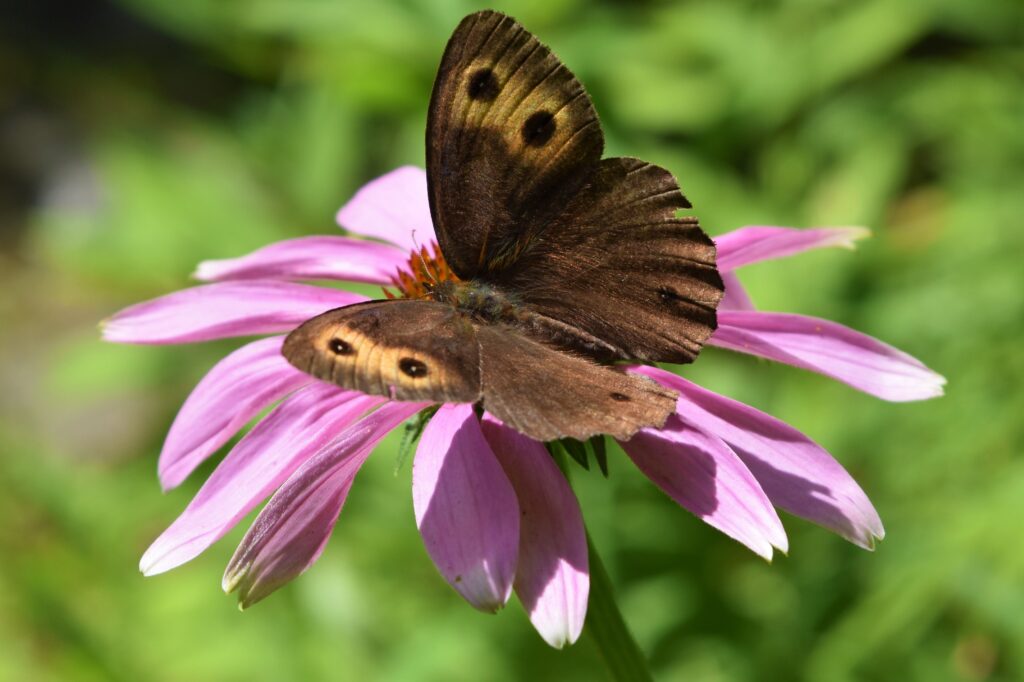
The common wood-nymph butterfly (
Cercyonis pegala) is a beautiful brown butterfly.
©Kerrie W/Shutterstock.com
Butterflies are an important figure across human culture and history. In fact, butterflies can be found in art as far back as the Neolithic period (c. 5000 BCE). Butterflies appear in art, religion, and philosophy in many different cultures. In this section, we will explore butterflies in ancient Egypt, ancient China, and Renaissance Europe. Across these cultures, butterflies have some symbolic meanings that are similar and some that are unique. Overall, butterflies are seen as a positive symbol.
Regeneration and the Afterlife in Ancient Egypt
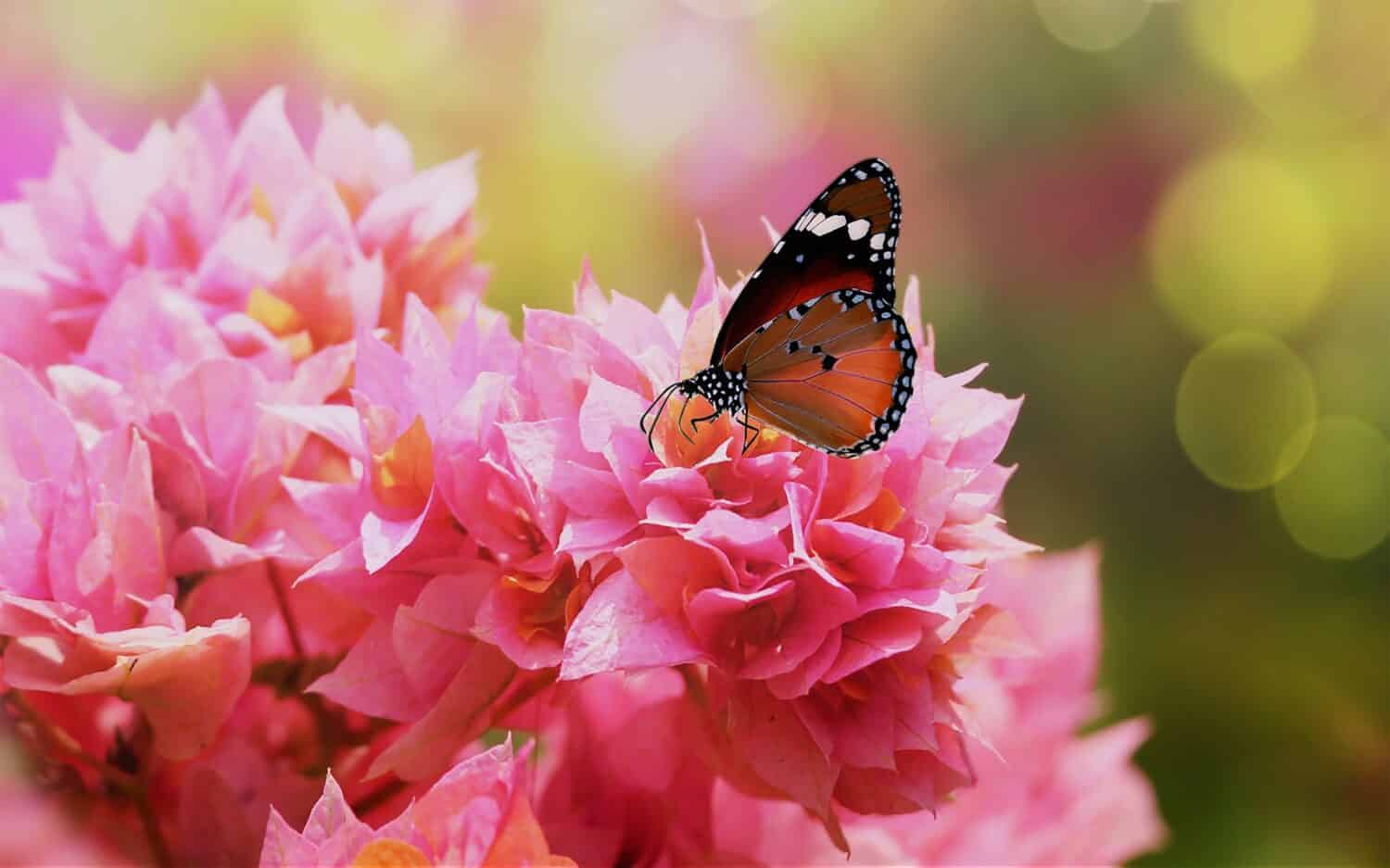
The plain
tiger
(
Danaus chrysippus) is the most common butterfly in Egypt.
©SL_Art/Shutterstock.com
From elaborate tombs to mummification, the afterlife was clearly a central part of ancient Egyptian life and culture. Pharaohs and other elite members of ancient Egyptian society all rest in lavish and unique tombs built to hold them for the eternity of the afterlife. These tombs are painted and carved with scenes depicting ancient Egyptian spirituality and beliefs about the afterlife. Images of butterflies sometimes appear in these tomb scenes, and most commonly in “marsh scenes.” In marsh scenes, the owner of the tomb is fishing or hunting waterfowl while butterflies typically rest or fly overhead. The plain tiger butterfly (danaus chrysippus), a brown butterfly, is the species that appears most in marsh scenes, and it remains the most common species in Egypt today. Scientists suspect that these brown butterflies are a symbol of transformation, regeneration, and the desire to overcome death in ancient Egyptian tomb scenes.
Luck and Longevity in Ancient China
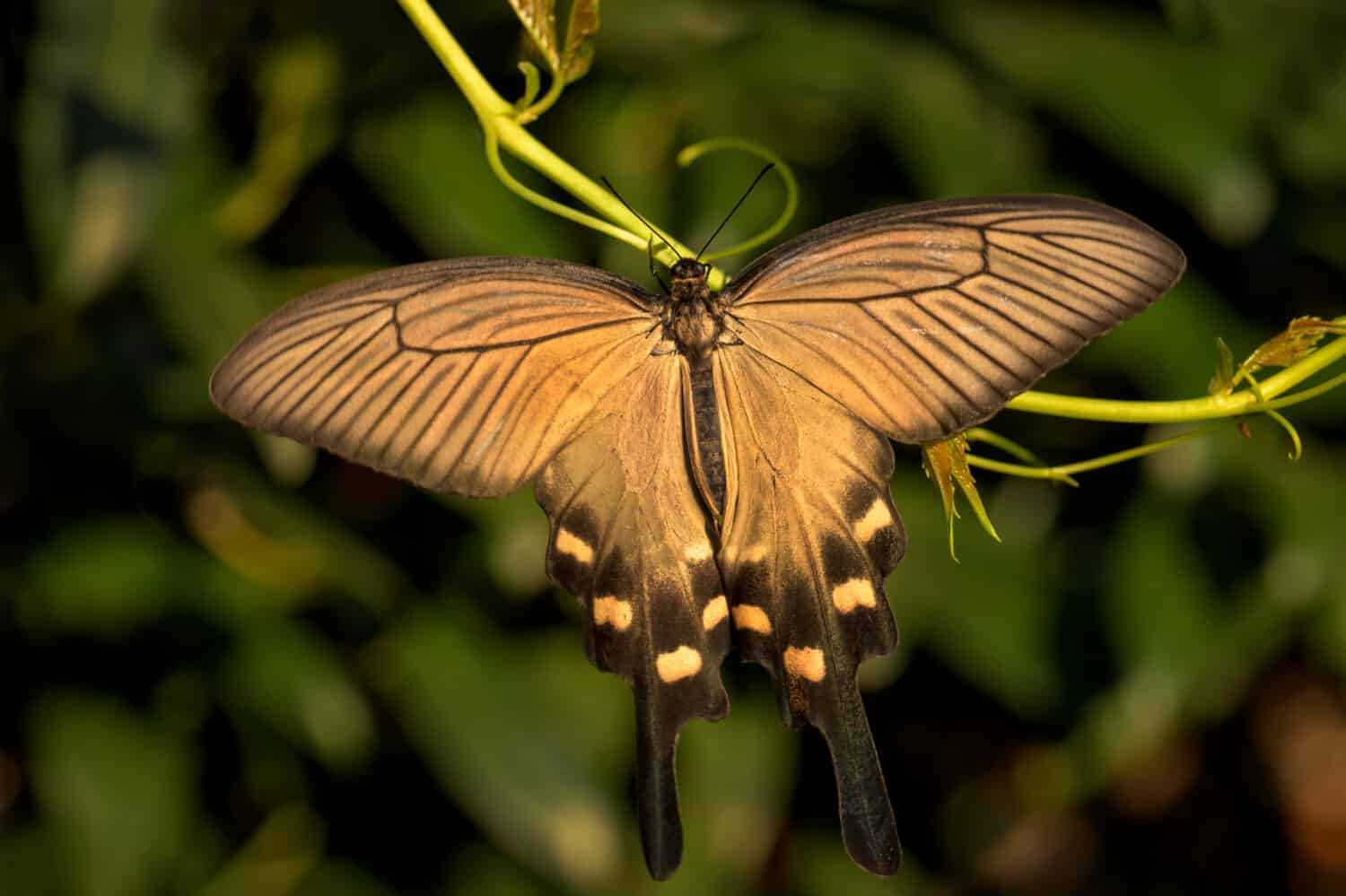
The Chinese windmill butterfly
(Atrophaneura alcinous) has a wingspan of up to 3.9 inches.
©David Havel/Shutterstock.com
The symbolic meaning of butterflies in Chinese culture appears in the Chinese word for butterfly, hú dié. Two characters make up this word. The first character sounds like the Chinese word for “good fortune,” and the second sounds like a word meaning “for the elders.” It follows that butterflies are a symbol of good luck and longevity in Chinese culture. Since butterflies have such positive and fortunate symbolism in Chinese culture, their image often appears in weddings. Butterflies are also an important symbol in feng shui, an ancient Chinese practice of art and design with the goal of harmonizing people and their environments. In feng shui, placing butterfly symbols in one’s home will bring the same benefits as a butterfly sighting, namely good luck and long life. The Chinese windmill (Atrophaneura alcinous), a large brown butterfly, is one of the 1,317 species of butterflies in China.
Transformation in Taoist Philosophy
The butterfly also appears as a symbol in ancient Taoism, most famously in a parable by the philosopher Chuang-Tzu. Taoism is a Chinese religion dating at least as far back as the fourth century BCE. The core teachings of Taoism are harmony, naturalness, and spontaneity. Chuang-Tzu’s parable describes himself having a dream that he is a butterfly, flying around from flower to flower. When he wakes up, he cannot tell if he is Chuang-Tzu who just dreamed he was a butterfly or a butterfly now dreaming it is Chuang-Tzu. The philosopher concluded that there must be a difference between Chuang-Tzu and the butterfly, but the boundary is able to be broken. He called this concept “the transformation of things,” only possible when one does not cling to the differences between oneself and others. Therefore, the butterfly is a symbol for the possibility of transformation in this parable.
Rebirth in Renaissance Europe and Christianity
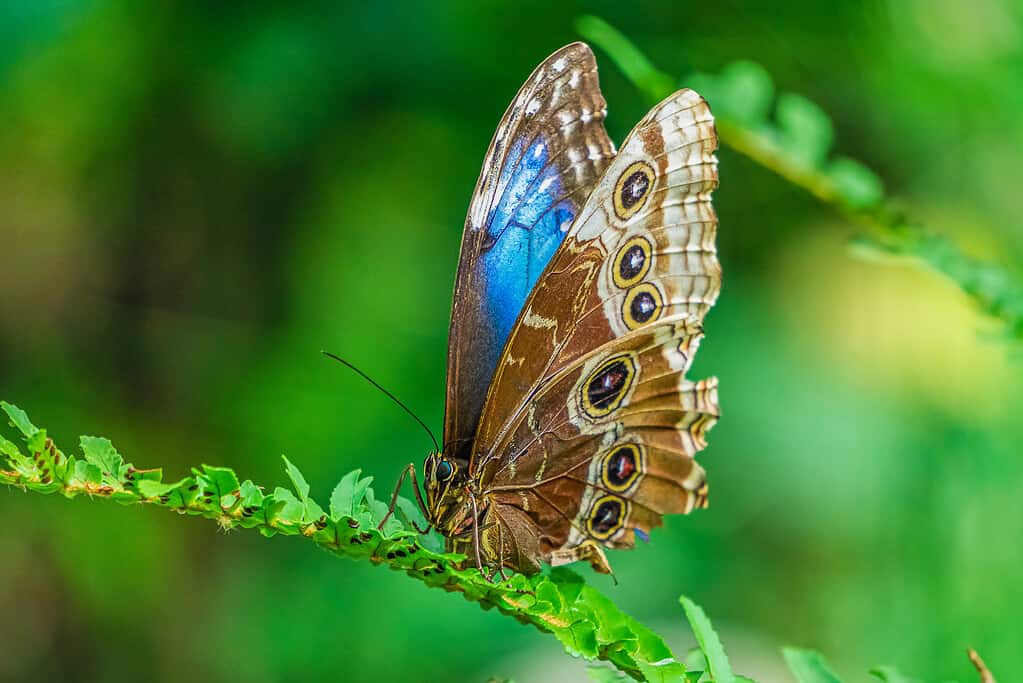
Here, a blue morpho butterfly (
Morpho peleides) shows its brown underside that is used for camouflage.
©Seda Yalova/Shutterstock.com
During the European Renaissance, knowledge and discovery were key values that drove society. An explosion of art, literature, and science set the stage for the daily life of Europeans during this time. Science and enlightenment values were at the core of Renaissance culture, a major shift from previous religious conceptions of the world. For Renaissance Europeans, the transformation of caterpillars into butterflies was a symbol of this dramatic rebirth of knowledge. For this reason, European publishers at the time would use a butterfly symbol as a publishing trademark. Additionally, some Renaissance people collected Morpho butterflies, which were brought back from Central America by European colonizers. These butterflies especially captivated Europeans due to the dramatically different coloring on the inside of their wings compared to the outside. The inside of Morpho butterfly wings features dazzling colors, while the outsides are brown for camouflage.
Resurrection in Christianity
As much as enlightenment philosophy and Christianity often represented different points of view during the Renaissance, butterflies are a symbol of rebirth for both. While enlightenment philosophy sees butterflies as the rebirth of knowledge, Christian spirituality interprets them to represent the resurrection of Christ. This meaning comes from the comparison of a caterpillar disappearing into a cocoon only to later re-emerge as a butterfly to Jesus’ time spent in the tomb before emerging alive. Since butterflies are a symbol of resurrection in Christian culture, people often use butterfly imagery for Easter, the holiday celebrating the resurrection. Additionally, Easter is a holiday in spring, which is the season when butterflies re-emerge from their winter dormancy.
Brown Color Psychology and Symbolism
How does color play a role in how people interpret brown butterfly sightings? The world is full of color, and these colors are constantly communicating information to us. Color influences perception in both subtle and overt ways. The science of color psychology studies the effect of colors on human behavior. Color psychology states that the meaning of a color can be innate or learned. Some color meanings are universal and arise from how the color appears in the natural world. On the other hand, each person has a different life experience and might associate a color with a unique meaning based on that experience. As for universal meanings for the color brown, some common ones are earth, warmth, and security. Since brown is the color of the earth and soil, it can communicate feelings of stability and grounding.
Interpreting Brown Butterfly Sightings

A great purple hairstreak (
Atlides halesus) resting on a dry Persimmon leaf.
©Sari ONeal/Shutterstock.com
Across different cultures, butterflies generally carry positive meanings. For example, in various cultures butterflies are symbols of transformation, renewal, good luck, and longevity. In order to interpret butterfly sightings, humans have a rich history of meaning and symbolism to draw from. As for brown butterfly sightings in particular, the color brown adds a layer of meaning with its association with earth and stability.
The photo featured at the top of this post is © Deep Desert Photography/Shutterstock.com
Thank you for reading! Have some feedback for us? Contact the AZ Animals editorial team.




